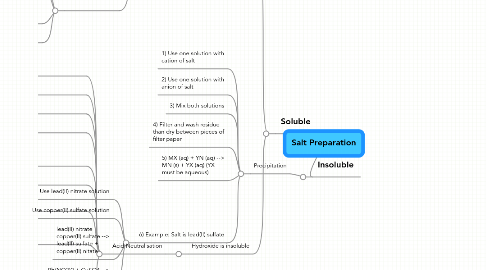
1. Soluble
1.1. Hydroxide is soluble
1.1.1. Titration
1.1.1.1. 1) Record the exact amount of hydroxide and acid needed for complete neutralization
1.1.1.2. 2) Use soluble hydroxide for cation
1.1.1.3. 3) Use acid for anion
1.1.1.4. 4) Mix both recorded amounts of both solution
1.1.1.5. 5) Crystallize the solution mixture to obtain pure salt crystals required.
1.1.1.6. 6) acid + hydroxide --> salt + water
1.1.1.7. 7) Example: Salt is potassium nitrate
1.1.1.7.1. Use potassium hydroxide (soluble)
1.1.1.7.2. Use nitric acid
1.1.1.7.3. potassium hydroxide + nitric acid --> potassium nitrate + water
1.1.1.7.4. KOH + HNO3 --> KNO3 + H2O
1.2. Hydroxide is insoluble
1.2.1. Acid Neutralisation
1.2.1.1. 1) Use insoluble metal, metal oxide, or metal carbonate for cation
1.2.1.2. 2) Use acid for anion
1.2.1.3. 3) Add insoluble substance to acid
1.2.1.4. 4) Filter and remove the residue.
1.2.1.5. 5) Crystallize the filtrate to obtain pure salt crystals required.
1.2.1.6. 6) metal + acid --> salt + hydrogen
1.2.1.7. 7) metal oxide + acid --> salt + water
1.2.1.8. 8) metal carbonate + acid --> salt + carbon dioxide + water
1.2.1.9. 9) Example: Salt is iron(II) chloride
1.2.1.9.1. Use iron OR iron oxide OR iron carbonate
1.2.1.9.2. Use hydrochloric acid
1.2.1.9.3. iron + hydrochloric acid --> iron(II) chloride + hydrogen
1.2.1.9.4. Fe + 2HCl --> FeCl2 + H2
1.2.1.9.5. iron(II) oxide + hydrochloric acid --> iron(II) chloride + water
1.2.1.9.6. FeO + 2HCl --> FeCl2 + H2O
1.2.1.9.7. iron(II) carbonate + hydrochloric acid --> iron(II) chloride + carbon dioxide + water
1.2.1.9.8. FeCO3 + 2HCl --> FeCl2 + CO2 + H2O
2. Insoluble
2.1. Precipitation
2.1.1. 1) Use one solution with cation of salt
2.1.2. 2) Use one solution with anion of salt
2.1.3. 3) Mix both solutions
2.1.4. 4) Filter and wash residue than dry between pieces of filter paper
2.1.5. 5) MX (aq) + YN (aq) --> MN (s) + YX (aq) (YX must be aqueous)
2.1.6. 6) Example: Salt is lead(II) sulfate
2.1.6.1. Use lead(II) nitrate solution
2.1.6.2. Use copper(II) sulfate solution
2.1.6.3. lead(II) nitrate + copper(II) sulfate --> lead(II) sulfate + copper(II) nitate
2.1.6.4. Pb(NO3)2 + CuSO4 --> PbSO4 + Cu(NO3)2
